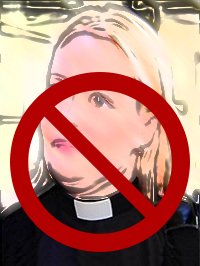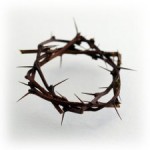
Nope.
An offshoot of the women priests heresy which I wrote about last spring, is women deacons. Usually the same flawed feminist / equal rights / non-discrimination / equality nonsense is heard. The answer is still no for all the same reasons. Women can not be ordained to any Holy Order – bishop, priest or deacon.
“Only a baptized man (vir) validly receives sacred ordination.” The Lord Jesus chose men (ver) to form the college of the twelve apostles, and the apostles did the same when they chose collaborators to succeed them in their ministry. The college of bishops, with whom the priests are united in the priesthood, makes the college of the twelve an ever-present and ever-active reality until Christ’s return. The Church recognizes herself to be bound by this choice made by the Lord himself. For this reason the ordination of women is not possible.
Wait just a minute there George (I imagine some “women libbers” might be saying at this point). Regardless of what the Catechism says (always a bad starting premise), there were deaconesses in the early Church, now there are not, so the Church must have done away with them. A prohibition against women deacons must be a type of discipline much as priest celibacy is in the Latin Rite.
This argument is raised every time the subject comes up. The fallacy is that deaconesses were female deacons, which was never the case. Deaconesses had a totally different, non-liturgical role. The name was often given to the wives of deacons or certain widows and their most notable purpose was to protect the modesty of women being baptized. In the early Church, baptism was done fully nude. Deaconesses assisted by holding a cloth between a woman being baptized and the priest. Deaconesses also performed as catechists for women, still a lay function but now done by either sex.
The full history of the Church, Holy Orders and deaconesses is complicated and a little muddied. The general practices have not changed, but some time was necessary for the Church to fully discern the roles of ordained clergy. The Council of Nicaea (325 AD) explicitly records “We have mentioned the deaconesses, who are enrolled in this position, but since they have not received any imposition of hands at all, they are surely to be numbered among the laity.” This does not imply that they were ever ordained to the same role as male deacons or were at the same level of deacons – they were not. To put them in proper context, their role was far closer to today’s uncloistered women religious (sisters).
The Church teaches that men and women have equal personal dignity, but with complimentary gifts and roles. We condemn discrimination against women that would deny them equal opportunity in professional and social life as unjust. Women are endowed with the same human rights as men. This does not mean they are functionally the same as men, and vice versa. Thankfully, God created men and women each for unique, important roles in the family and the Church.



























I must confess, this isn’t something I approach from a religious perspective, but as a classicist with an interest in history of religions in the ancient world. However, I’d be curious to know your perspective on some of the epigraphic evidence relating to female deacons. While there are many references both in texts and in inscriptions to deaconesses (that is, in Greek, deacon with a feminine definite article and feminine ending), there are also inscriptions in which we find women referred to as deacon, using the masculine ending, but with a feminine definite article. This is found in secular usage to denote female activity in spheres with masculine titles, and has thus been taken to suggest that while deaconess did indeed exist as a role of the sort you describe, there were also women who were carrying out the role of deacon as well.
Does the Church have a perspective on this?
Thanks for the interesting comment Scriptrix! I do not have any linguistic expertise (or even opinion) on your research.
There are many ways men and women serve the Church, from the early Church to the present. While it seems clear that there were women who were called deaconesses, their role then was not the role of deacons per the Council of Nicaea (the first ecumenical council, recognized by virtually all Christian communities). It is interesting to me that the council made that explicitly clear (canon 19).
Of course, when I speak of the Church I am speaking exclusively of the Catholic Church. That is, the Church instituted by Jesus, protected by the Holy Spirit until the end of time, and whose authority is passed and preserved through Holy Orders all the way back to the Apostles. The very name “Catholic” was used to distinguish the true Church from a wide variety of other groups who had other beliefs (which we call heresies and know to be false). I mention this because it occurs to me that these other groups may have had women deacons. If so, that would have no bearing on the truth any more than the actions of modern schismatic Christian communities do.
The role of deacon requires ordination to confer the grace and spiritual power for the discharge of the ecclesiastical office. The Church simply lacks the authority to ordain women. This in no way implies that women are inferior or less capable, just that we believe Jesus intends for this office to be filled by men. We recognize that men and women are completely equal in human dignity, but differ from each other leading to different roles in the Church and family.